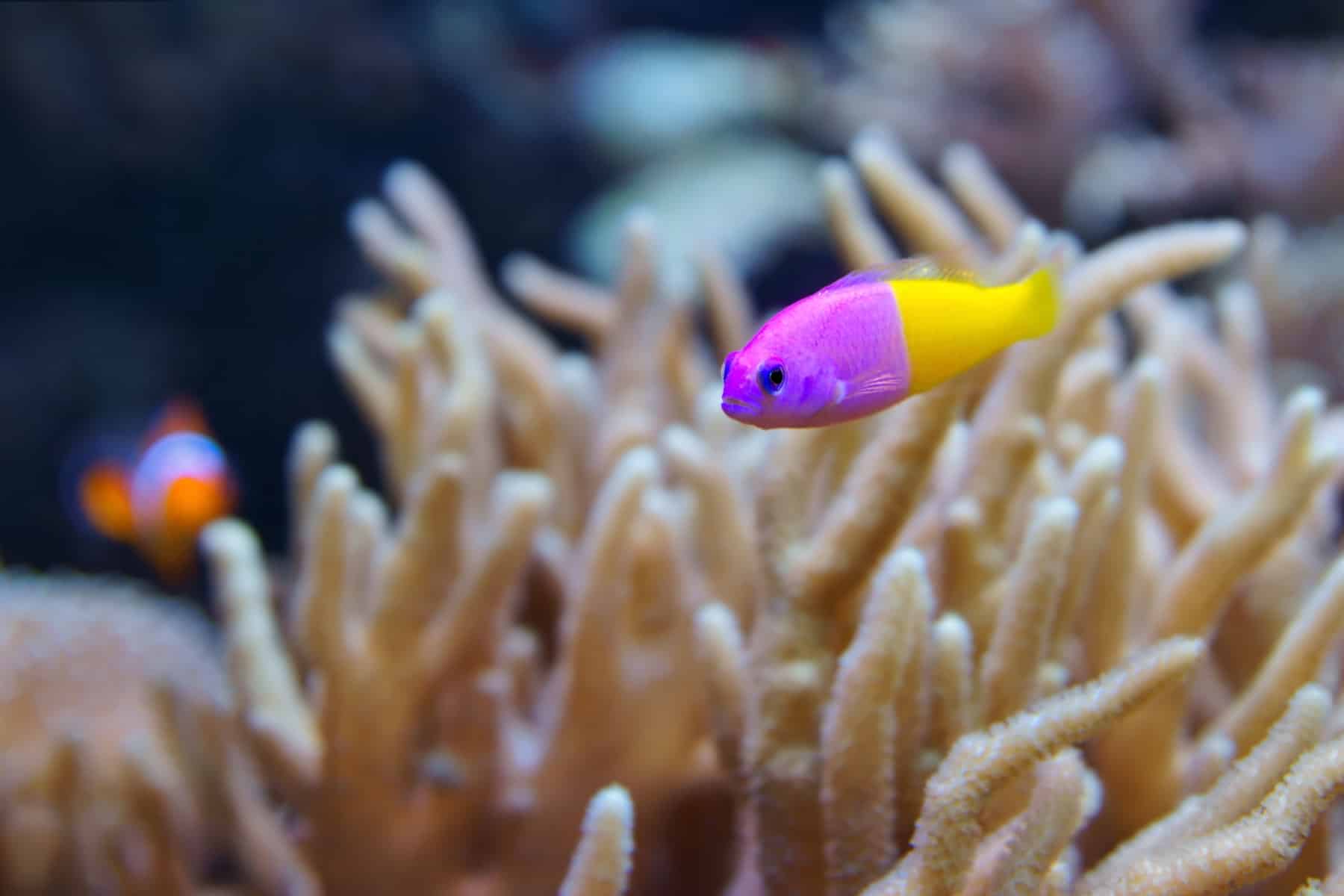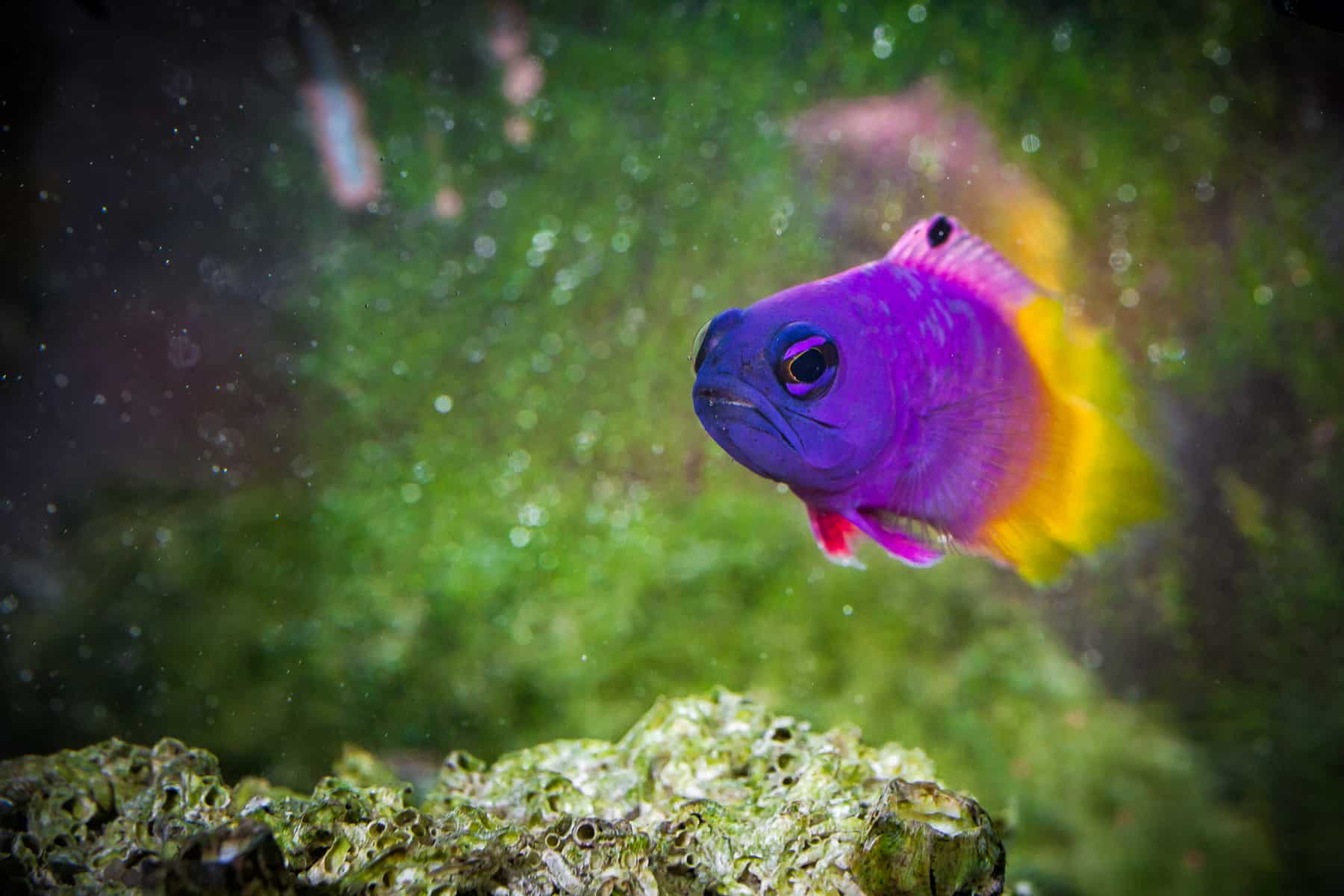The Royal Gramma is a stunningly vibrant colored fish that’s sure to catch the eye of any would-be hobbyist. These peaceful little fishes are easy to care for and very hardy, making them an ideal choice for both a beginner or an experienced marine enthusiast.
These saltwater fish are most at home in a large reef aquarium. So, if that sounds like your setup and you want a fish with A-lister looks that really make your tank pop, you’ll need to know how to care for the Royal Gramma!
In this detailed guide, we explain how to provide the optimum conditions that will enable your new star to thrive, including feeding, compatibility with other fish, tank conditions, water parameters, and more.
But first, let’s find out more about this aquatic gem.
Royal Gramma origins
The Royal Gramma, scientific name, Gramma Loreto, also has the common name, Fairy Basslet.
The species belongs to the Grammatidae family of ray-finned fishes that are found in tropical, saltwater reef environments of the western Atlantic, Caribbean Ocean. The Gramma Loreto’s range extends from the Bahamas, Lesser Antilles, Venezuela, Bermuda, through the seas off of Central America and northern South America.
In their wild environment, these brilliantly colored little fish live at depths of between three and 60 feet, inhabiting coral outcrops, expanses of rockwork, and reefs., where they have often been seen swimming upside down.
The current in these areas can be strong, and the Royal Gramma fish is not a strong swimmer, so it tends to hide in the caves and crevices of the rock, waiting for a particle of food to be carried past in the water flow. The Gramma darts out to grab the food and then retreats back into the safety of his den.
The Fairy Basslet is an abundant fish in the wild and is, therefore, noted on the IUCN Red List as a species of least concern.
Appearance
The Royal Gramma is a real stunner!
The front half of the fish’s body is a brilliant, iridescent violet color, blending in the middle of the body into a dramatic golden yellow shade toward the tail. Where the colors collide in the center of the fish’s body, each individual has a series of dots, making every fish unique. There’s also a fine black line, extending from the mouth and up through the fish’s eyes, as well as a small black spot on the animal’s dorsal fin.
These are small fish, growing to around 3 inches.
When it comes to determining the sex of the Royal Gramma, that can be a challenge, as the fish are all born female. However, when the fish are together in a school; the dominant individual in the group will change gender and become male. A male fish is larger than the female and has bigger ventral fins. Also, males are typically more vibrant in color than females.

Royal Dottyback
The Royal Dottyback (Pictichromis Paccagnellae) is a different species of fish that is frequently confused with the Royal Gramma.
However, although the two fish look similar, the Dottyback has a very aggressive nature and is generally incompatible with most other species, making it an unsuitable choice for beginners.
So, how do you tell the difference between a Gramma and a Dottyback?
Take a look at the fish’s coloring. You’ll see that where the Royal Gramma’s coloring gradually blends in the middle of the fish, the Royal Dottyback has no blending between the colors. Also, the Dottyback’s fins are clear.
Care and maintenance
Caring for the Royal Gramma is pretty straightforward, as long as you provide your fish with their correct and preferred tank and water conditions.
When observing your Gramma, you’ll notice that the fish has a habit of swimming with its belly toward the rock, often hanging upside down. That’s often mistaken as a sign of illness by beginner aquarists. However, that behavior is perfectly normal for Royal Grammas and is not a cause for concern.
Tank size
Now, although the Royal Gramma is a small fish, only reaching around 3 inches long when fully mature, a single fish will need to be kept in an aquarium of at least 30 gallons. That will allow plenty of space to accommodate the dense, rocky aquascape that these creatures prefer.
If you want to keep a pair of Grammas, you will need a tank of 50 gallons minimum, and a small group of these peaceful fish will need a tank of more than 100 gallons to be comfortable. As a general rule of thumb, for every fish over two, you should add another 20 gallons per individual.
A point to note when choosing a suitable tank for Royal Grammas is that these fish can, and do, jump. So, you’ll need to have a tank with a lid or at least a cover slide to prevent any escape attempts.
Water parameters
The Royal Gramma is a pretty hardy soul that can live happily in a fairly wide range of water conditions. However, if you keep the setup within the species’ ideal tolerance parameters, you’ll reduce the likelihood of disease and potentially prolong your fish’s lifespan.
The preferred water temperature for the Gramma is between 72° and 80° Fahrenheit. pH levels should be within the range of 8.1 to 8.4 with a carbonate hardness of 8° to 12° dKH, and a specific gravity of 1.020 and 1.025.
To be sure that the conditions within the aquarium remain within these ranges, you’ll need to carry out a weekly water quality test and make any necessary adjustments. Every week, you should change around 10% of the water in the tank. Also, you should use a power filter that will keep the habitat clean, as well as creating the strong flow that is preferred by the Royal Gramma.
Tank decoration
When decorating a tank for any species of fish, you should try to replicate the animal’s natural habitat as closely as possible. That will help the fish to settle in, preventing stress, encouraging feeding, and, hopefully, keeping disease outbreaks at bay.
In the case of the Royal Gramma, you’ll need to create a deep-water reef. You can do that by using a live sand substrate and decorating the tank with lots of live rock piles, caves, crevices, and nooks and crannies where the fish can shelter. If you don’t want to use live rock, artificial resin rocks will do fine. A helpful safety tip is to use aquarium glue to fix the rocks together so that there’s no danger of overhangs collapsing and injuring your fish.
The ambient lighting in the fish’s natural environment is dim, so do not use very bright or harsh light in the aquarium. If it suits the majority of species in the community, a mauve mood or moonlight lighting effect is ideal.
Diet and feeding
In nature, the Royal Gramma primarily feeds on zooplankton and phytoplankton. The fish is also known as a cleaner fish, eating the parasites that it finds on the skin of other fish.
In the aquarium, these fish are not fussy feeders, and they will happily eat small meaty live foods, including Mysis shrimp and brine shrimp. The Gramma can also be taught to accept dead food, such as fish flesh and crustaceans, which you can buy frozen for easy storage and longevity. Although they aren’t part of the Royal Gramma’s natural diet, the fish will accept live and frozen bloodworms.
Before feeding your fish with frozen foods, be sure to thaw the food thoroughly in a little tank water, and then add it to the water so that the pump flow carries the food particles around with it.
You can also feed Royal Grammas with pellet and flake foods, although you should mix and match the fish’s diet to keep them interested and provide a good nutritional balance.
If possible, it’s best to feed your fish several times during the day. That said, the Gramma Loreto will be quite content with one daily feed if that’s all you can manage. Grammas prefer to feed in the middle area of the water column, darting out from their hiding places to snatch food particles that drift close to them.
Tankmates
Royal Grammas are generally peaceful fish that get on well with most species, including:
Invertebrates and corals can also be kept safely with Royal Grammas.
As a general rule, Royal Grammas are peaceful as long as the fish they are kept with are also non-aggressive. Also, you should not introduce species that look similar to the Gramma, especially bright purple colored fish, including Royal Dottybacks.
Large predatory species should also be avoided, including eels, snappers, groupers, and Lionfish. These giants are more than capable of eating a Royal Gramma, and their presence in the tank can cause very high levels of stress, which are potentially harmful to other vulnerable residents in the community.
Also, the Royal Gramma can be territorial, chasing other fish away if they attempt to steal a favorite spot within the rock.
Keeping groups of Gramma Loreto
Because of the species’ territorial nature, it’s generally recommended by experts that you keep only one specimen. However, if you do decide to keep a pair of Royal Grammas, a tank of 30 gallons is too small. You’ll need an aquarium of at least 50 gallons in size that has lots of rocky structures, caves, and overhangs so that both the fish have plenty of space. If possible, you should keep one male and one female together as a pair.
If you have a super-large tank of over 100 gallons, you might want to keep a group or harem of Royal Grammas. To do that, it’s essential that you introduce the group at the same time, and be sure to provide plenty of rockwork. When you choose a group of Grammas, pick the smallest specimens, which are most likely to be females.

Breeding
In the wild, the breeding season for Royal Grammas is during the spring and summer months when the water warms up. Spawning takes place on a daily basis during this time in month-long stints. Compared with many of the marine fish, the Royal Gramma is also surprisingly easy to breed in the home aquarium.
The breeding activity begins with the male fish constructing a nest from algae and small rocks. The female fish then deposits between five to 40 eggs in the nest, which adhere to the algae. The male fish then fertilizes the eggs, and they remain in the nest for the next five to seven days until they hatch.
Hatching usually takes place when the sun sets, and the reef is dark. The eggs hatch in small batches, and that’s what makes raising the fry problematic. That’s because there is a notable difference in the size of the tiny Grammas’ mouths. Your best bet is to feed the fry rotifers and copepods until the youngsters are large enough to eat newly hatched brine shrimp.
Diseases and health
Royal Grammas are robust and generally hardy fish that can live for five or six years if given the correct tank size, conditions, and a balanced diet.
The main dangers to the fish are Marine Ich, as well as bacterial and fungal infections.
However, provided that the Royal Gramma is not stressed by exposure to aggressive tankmates or incorrect water conditions, he should remain healthy.
Marine Ich
Marine Ich is caused by the Cryptocaryon irritans parasite and presents in a similar way to White Spot disease in freshwater fish.
Fish that are infected with Cryptocaryon develop tiny white spots across their skin, gills, and fins. As the disease progresses, affected fish become thin, may change color, produce increased quantities of mucus, have cloudy eyes and ragged fins. Infected fish may flick against the rocks and substrate, hang at the water surface, and may breathe very rapidly as if in distress.
Marine Ich is extremely difficult to treat in a reef setup, largely because the standard over-the-counter treatments for the disease are extremely harmful to invertebrates and corals. For that reason, you’ll need to remove affected fish from the tank and place them in a quarantine aquarium. Treat the fish with a copper salt, over-the-counter product, or using hyposalinity of 1.009 specific gravity.
The fish will need to remain in the quarantine tank for six to nine weeks or even longer. That allows sufficient time for the encysted tomont form of the parasite to release the infectious theronts, which will die within a day or two when there is no host for them to latch onto.
Availability
Thanks to its ease of breeding, the Royal Gramma is widely available in good marine fish stores and through online suppliers.
The price of Royal Grammas varies depending on the size of the specimen, but you can expect to pay between $30 and $40 dollars for a single individual. Remember that you’ll need to add the cost of shipping to the price of the animal if you buy online.
Final thoughts
The stunning Royal Gramma is a must-have fish for anyone thinking of starting a marine or reef aquarium.
These brightly colored little saltwater fish are easy to care for, are extremely hardy, and they will provide you with enjoyment for up to six years if properly housed and fed a well-balanced diet.
Note that you will need a large tank of at least 30 gallons that is kitted out with plenty of live rock, caves, crevices, and hiding places for this peaceful but territorial little aquatic gem.


























